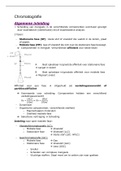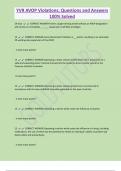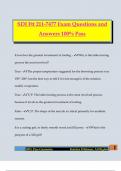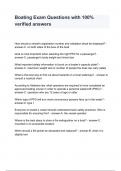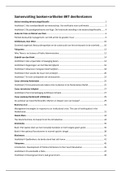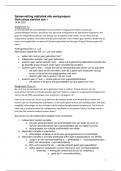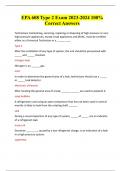Chromatografie
Algemene inleiding
= Scheiding van mengsels in de verschillende componenten eventueel gevolgd
door kwalitatieve (identificatie) en/of kwantitatieve analyse.
2 fasen:
- Stationaire fase (SF): Vaste stof of vloeistof die vastzit in de kolom, plaat
of papier.
- Mobiele fase (MF): Gas of vloeistof die zich over de stationaire fase beweegt.
Componenten in mengsel: Verschillende affiniteit voor beide fasen
MF
Eluent
+ staal
SF Elutie A Best oplosbaar in/grootste affiniteit voor stationaire fase
→ Langst in kolom
B Best oplosbaar in/grootste affiniteit voor mobiele fase
→ Migreert snelst
Eluaat
Affiniteit voor een fase → Uitgedrukt als verdelingsevenwicht of
partitiecoëfficiënt
Voorwaarde voor scheiding: Componenten hebben een verschillend
verdelingsevenwicht
[𝐴]𝑠𝑓 [𝐵]𝑠𝑓
𝐾𝑎 = ≠ 𝐾𝑏 =
[𝐴]𝑚𝑓 [𝐵]𝑚𝑓
- Dynamisch
- Organische componenten: verschillende snelheid
Eigenschappen moleculen
Snelheid mobiele fase
Selectieve vertraging → Scheiding
Indeling naar aard mobiele fase:
- Vloeistofchromatografie (LC):
o Mobiele fase → Vloeistof
o Stationaire fase → Vloeistof (LLC)
→ Vaste stof (LSC: HPLC)
- Gaschromatografie (GC):
o Mobiele fase → Gas
o Stationaire fase → Vloeistof (GLC)
→ Vast (GSC)
+ Sneller
+ Scheiden van complexe mengsels
− Vluchtige stoffen: Staal moet om te zetten zijn naar gasfase
, Staalvoorbereiding
EXTRACTIE
- Isoleren doelwitcomponenten
- Concentreren
- Verwijderen interfererende componenten :
o Eiwitten → Enzymen, denaturatie
o Vetten → Lipasen
o Conjugaten → Verhitten bij lage pH, enzymen
Vloeistof – vloeistof extractie
Polariteit:
- Likes likes like
- Extractiebuisje of – trechter
Vaste fase extractie
= Voorbereiding: Opzuiveren bepaalde analieten uit een mengsel om deze erna
met een andere methode te analyseren
Analoog aan principes chromatografie:
o Selectieve verdeling over SF en MF
o Normal – en reversed phase
o Ionenuitwisselingschromatografie
Stappen:
1. Selectie kolom: Specifiek om bepaalde componenten af te zonderen
2. Conditionering kolom: MF laten doorlopen en kolom vochtig maken
3. Lading staal: Deels blijven hangen en deels doorlopen
4. Wasstap: Alles wat niet gebonden is verwijderen
5. Elutiestap: Alles wat wel gebonden is losmaken
6. Droogdampen: Concentratie verhogen
7. Eventueel derivatisatie: Chemische modificatie om stoffen bruikbaar te maken
voor verdere analyse
Toepassingen:
- Klinische chemie
- Minikolommen voor zuiveren DNA, RNA, GM
Standaardisatie
Voor kwantitatieve bepalingen: Standaard met gekende concentratie
Interne standaard → Meest accuraat
- Verschillend van analiet → Homoloog (fluctuatie opvangen)
Identieke fysische/chemische eigenschappen als analyt: detecteerbaar
- Toegevoegd aan staal = spiken
- Signaal interne standaard vergelijken met signaal staal
Algemene inleiding
= Scheiding van mengsels in de verschillende componenten eventueel gevolgd
door kwalitatieve (identificatie) en/of kwantitatieve analyse.
2 fasen:
- Stationaire fase (SF): Vaste stof of vloeistof die vastzit in de kolom, plaat
of papier.
- Mobiele fase (MF): Gas of vloeistof die zich over de stationaire fase beweegt.
Componenten in mengsel: Verschillende affiniteit voor beide fasen
MF
Eluent
+ staal
SF Elutie A Best oplosbaar in/grootste affiniteit voor stationaire fase
→ Langst in kolom
B Best oplosbaar in/grootste affiniteit voor mobiele fase
→ Migreert snelst
Eluaat
Affiniteit voor een fase → Uitgedrukt als verdelingsevenwicht of
partitiecoëfficiënt
Voorwaarde voor scheiding: Componenten hebben een verschillend
verdelingsevenwicht
[𝐴]𝑠𝑓 [𝐵]𝑠𝑓
𝐾𝑎 = ≠ 𝐾𝑏 =
[𝐴]𝑚𝑓 [𝐵]𝑚𝑓
- Dynamisch
- Organische componenten: verschillende snelheid
Eigenschappen moleculen
Snelheid mobiele fase
Selectieve vertraging → Scheiding
Indeling naar aard mobiele fase:
- Vloeistofchromatografie (LC):
o Mobiele fase → Vloeistof
o Stationaire fase → Vloeistof (LLC)
→ Vaste stof (LSC: HPLC)
- Gaschromatografie (GC):
o Mobiele fase → Gas
o Stationaire fase → Vloeistof (GLC)
→ Vast (GSC)
+ Sneller
+ Scheiden van complexe mengsels
− Vluchtige stoffen: Staal moet om te zetten zijn naar gasfase
, Staalvoorbereiding
EXTRACTIE
- Isoleren doelwitcomponenten
- Concentreren
- Verwijderen interfererende componenten :
o Eiwitten → Enzymen, denaturatie
o Vetten → Lipasen
o Conjugaten → Verhitten bij lage pH, enzymen
Vloeistof – vloeistof extractie
Polariteit:
- Likes likes like
- Extractiebuisje of – trechter
Vaste fase extractie
= Voorbereiding: Opzuiveren bepaalde analieten uit een mengsel om deze erna
met een andere methode te analyseren
Analoog aan principes chromatografie:
o Selectieve verdeling over SF en MF
o Normal – en reversed phase
o Ionenuitwisselingschromatografie
Stappen:
1. Selectie kolom: Specifiek om bepaalde componenten af te zonderen
2. Conditionering kolom: MF laten doorlopen en kolom vochtig maken
3. Lading staal: Deels blijven hangen en deels doorlopen
4. Wasstap: Alles wat niet gebonden is verwijderen
5. Elutiestap: Alles wat wel gebonden is losmaken
6. Droogdampen: Concentratie verhogen
7. Eventueel derivatisatie: Chemische modificatie om stoffen bruikbaar te maken
voor verdere analyse
Toepassingen:
- Klinische chemie
- Minikolommen voor zuiveren DNA, RNA, GM
Standaardisatie
Voor kwantitatieve bepalingen: Standaard met gekende concentratie
Interne standaard → Meest accuraat
- Verschillend van analiet → Homoloog (fluctuatie opvangen)
Identieke fysische/chemische eigenschappen als analyt: detecteerbaar
- Toegevoegd aan staal = spiken
- Signaal interne standaard vergelijken met signaal staal

